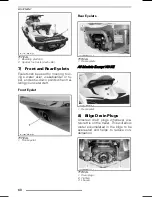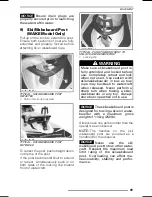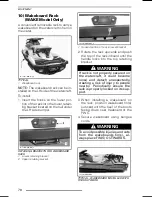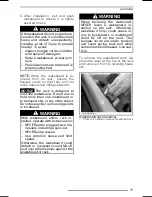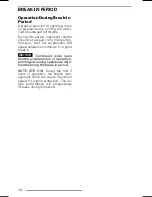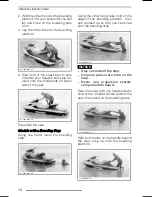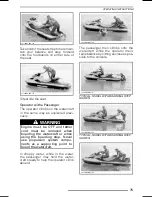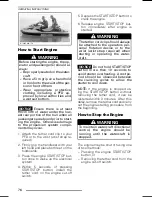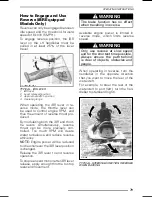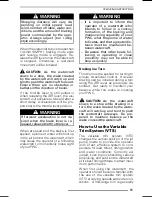
OPERATING INSTRUCTIONS
WARNING
Stopping distance will vary de-
pending on initial speed, load,
wind, number of riders, water con-
ditions, and the amount of braking
power commanded by the oper-
ator. Always adjust your riding
style accordingly.
When the watercraft slows to less than
14 km/h (9 MPH), braking mode ends
and reverse mode is engaged. Re-
lease the iBR lever once the watercraft
is stopped. Otherwise, a rearward
movement will be initiated.
CAUTION
As
the
watercraft
slows to a stop, the wake created
by the watercraft will catch up and
tend to push the watercraft forward.
Ensure there are no obstacles or
bathers in the direction of travel.
If the throttle lever is still pulled in
when releasing the iBR lever, the wa-
tercraft will accelerate forward after a
short delay. Acceleration will be pro-
portional to the throttle lever position.
WARNING
If forward acceleration is not de-
sired when the brake lever is re-
leased, release the throttle lever.
When at speed and the brake is first
applied, a plume of water will shoot up
in the air behind the watercraft which
may cause the operator of a following
watercraft to momentarily loose sight
of your PWC.
WARNING
– It is important to inform the
operator of a watercraft who
intends to follow in a convoy
formation, of the braking and
maneuvering capability of your
PWC, what the plume of water
indicates, and that a greater dis-
tance must be maintained be-
tween watercraft.
– Be aware that other boats fol-
lowing or operating in close
proximity may not be able to
stop as quickly.
Braking in a Turn
Throttle must be applied for turning to
ensure directional control. However
braking can be initiated during a turn
using the iBR lever as previously de-
scribed. Get ready to maintain your
balance while the wake is crossing
your PWC.
CAUTION
As
the
watercraft
slows to a stop while braking in a
turn, the wake created by the water-
craft will catch up and tend to push
the watercraft sideways. Be pre-
pared to maintain balance as the
wake crossed the watercraft.
How to Use the Variable
Trim System (VTS)
The
variable
trim
system
(VTS)
changes the vertical position of the jet
pump nozzle to provide the operator
with a fast, effective system to com-
pensate for load, thrust, riding position
and water conditions. Correctly ad-
justed, it can improve handling, reduce
porpoising, and position the watercraft
at its best riding attitude to attain maxi-
mum performance.
When first using the watercraft, the
operator should become familiar with
the use of the variable trim system
(VTS) at varying speeds and water con-
ditions. A mid-range trim is generally
_______________
81
Содержание GTI Series
Страница 9: ...SAFETY INFORMATION ________ SAFETY INFORMATION ________ 7 ...
Страница 43: ...WATERCRAFT INFORMATION _______________ 41 ...
Страница 45: ...CONTROLS smo2016 001 003_a GTI LIMITED MODEL smo2016 001 004_a GTR MODEL _______________ 43 ...
Страница 46: ...CONTROLS smo2016 001 300_a WAKE MODEL 44 ______________ ...
Страница 106: ...SPECIAL PROCEDURES This page is intentionally blank 104 ______________ ...
Страница 107: ...MAINTENANCE INFORMATION ______________ 105 ...
Страница 125: ...TECHNICAL INFORMATION ______________ 123 ...
Страница 137: ...TROUBLESHOOTING ______________ 135 ...
Страница 148: ...MONITORING SYSTEM This page is intentionally blank 146 ______________ ...
Страница 149: ...WARRANTY ______________ 147 ...
Страница 171: ...CUSTOMER INFORMATION ______________ 169 ...
Страница 174: ...CHANGE OF ADDRESS OWNERSHIP This page is intentionally blank 172 ______________ ...
Страница 175: ...CHANGE OF ADDRESS OWNERSHIP ______________ 173 ...
Страница 176: ...CHANGE OF ADDRESS OWNERSHIP This page is intentionally blank 174 ______________ ...
Страница 177: ...CHANGE OF ADDRESS OWNERSHIP ______________ 175 ...
Страница 178: ...CHANGE OF ADDRESS OWNERSHIP 176 ______________ ...
Страница 179: ......


